
|   |

|   |
 e-mail: sunilkothari1933@gmail.com Vienna Diary: Natya Mandir and Radha Anjali Photos courtesy: Radha Anjali October 16, 2016 Vienna University (Universitat Wien) confirmed my lecture and screenings of the excerpts of films on Uday Shankar, Ram Gopal and Mrinalini Sarabhai on June 16, 2016, well in advance, therefore the last leg of my Europe tour was finalized and I had a glorious week in Vienna, the beautiful capital of Austria. The lecture was held at the seminar room of The Institute for South Asian, Tibetan and Buddhist Studies. By a happy coincidence, celebrated Kathak exponent Shovana Narayan with her husband Herbert Traxl, former Ambassador to India, was also in town. After retirement, Traxl also gives lectures in the same university. Radha Anjali, a disciple of Kamadev, Adyar K. Lakshman and Kalanidhi Narayanan runs her institution Natya Mandir in Vienna for past 30 years. Thanks to Kamadev, we had met many years ago when I had visited Vienna with Kamadev. They were to perform Seraikella Chhau dances in Vienna. I was instrumental in introducing Kamadev to Seraikella Chhau in 1968 when we met In London. I had taken with me few copies of special issue of Marg edited by me on Chhau Dances of India (Dec1968). Kamadev (we used to address him as Kama) was planning to visit Chennai again to study further under Subbaraya Pillai, son of Chokkalingam Pillai, and also pursue Kuchipudi under Vempati Chinna Satyam. He wanted to learn masked dances of Seraikella also. We visited Seraikella village and met Guru Kedarnath Sahoo, under whom Kama studied Chhau. During his tours in Europe, he used to present Chhau with Pradip Kar and other dancers from Seraikella. It was during that tour that we had stayed with Radha Anjali. We also visited Schönbrunn Palace and got some interesting photos taken against the backdrop of the palace. Radha Anjali had very kindly traced those photos from her archive, since I was to meet her. Vienna as the capital of Austria is one of the finest cities with exquisite architecture. During my very first visit way back in1969, I had, with a leading ballet dancer Karl Musil, visited the Opera House. By fortuitous circumstances at that time the opera Magic Flute was staged there and Karl Musil took me to attend it. One was awed by the architecture of the Opera House, the red coloured plush seats, the lights, the ceiling and decoration, the foyer and the acoustics. Opera is a connoisseurs' art form and one has to have taste for it. I cannot claim to have an understanding of it but the voices of the opera singers astound us. The opulence, the backdrops, and costumes of the opera singers are visually stunning. Shovana and her Kathak students were to perform at the Danube Festival and later on at Salzburg. She and Herbert invited me to a vineyard for special wine and dinner at Heunigen, where Beethovan had spent his last years. A lovely place in almost a countryside, it transported us to a resort like place where young and old spend evenings ordering the wine, special bread and other delicacies. The atmosphere is full of joie de vivre and fun. The wine was of course a special attraction. The ambience was pleasant. There were a few posters giving history of the place. The cobbled paths, the mandapa like structure with creepers of vine and other flowers covering the ceiling created a romantic mood. We caught up with the latest in the dance world. The evening was well spent. Next day was the lecture, so we went to the department earlier for a tech check, to avoid being let down during the talk. The seminar room was quite spacious. There were other Indian scholars and few dancers, one from Pune, a disciple of Shama Bhate and other an Odissi dancer. The screening went off well, but at one point the sound went off. I had a spare pen drive with recording, but somehow the sound could not be restored. Therefore I spoke along with the screening! The University campus has a vast area and several faculties. There were big screens placed for crowds to watch football game. During my entire stay in Paris, Berlin, Vienna the football fever was on. And we were literally competing with football games but thanks to advance announcements, we had good audience. Radha Anjali's husband is Iranian Prof. Jalil Saber Zainian, an architect and in charge of large buildings of the University, with a staff of more than 200 workers. Next day, we were to have a workshop and my talk specially for Radha Anjali's senior disciples who form her troupe and regularly practice the margam repertoire. Natya Mandir is on ground floor and the building belongs to Radha Anjali's parents. Her mother is a Sanskrit scholar and deeply interested in yoga. I saw in her library, Sanskrit books on Panini, Patanjali and Indian religion. Both her parents are Indologists, and are interested in Indian philosophy. At a very young age, Radha Anjali was introduced to India when the family visited India in 1972. She had come across a book of Indian dance published by Indian Tourism Dept with photos of Uday Shankar, Ram Gopal, Kumudini Lakhia, Tara Choudhary, Shanta Rao, Madame Menaka, Kathakali dancer Guru Gopinath and she read it again and again and knew their names by heart. 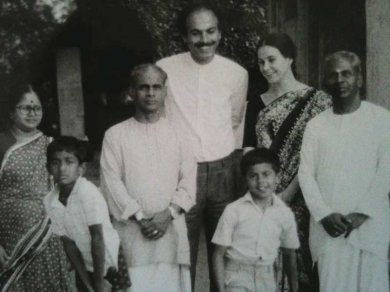 Adyar K. Lakshman, Prof. Jalil, Radha Anjali, Adyar Rama Rao 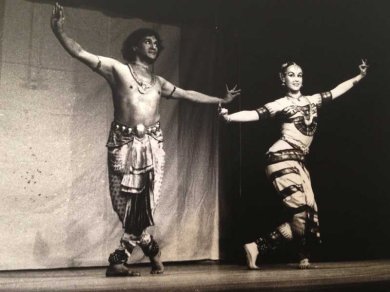 Kamadev & Radha Anjali 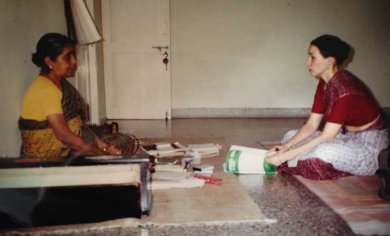 Class with Kalanidhi Narayanan But her interest in Indian classical dance was generated by two Parsi female dancers, who had come to Vienna to study medicine and nursing. Both of them were dancers having studied Bharatanatyam, Kathak and Manipuri. They were Abanbana and Dilnawaz from Mumbai. Seeing them perform Alarippu, Radha Anjali used to copy it and seeing her interest they taught her a few items. The sisters could not make it to study further and when met with financial reverses, they stayed for six months with Radha Anjali's parents. Later on they moved and managed to get jobs as nurses and did well and returned to Mumbai. Radha Anjali says that she owes her love for Indian classical dances to these two sisters. When she met Kamadeva in Vienna in 1978, she had already studied classical ballet, Flamenco, modern dance and Martha Graham technique at Konservatorium der Stadt Wien. But when she saw Bharatanatyam performance by Kama, she was so moved that she wanted to study Bharatanatyam like Kama. She performed Alarippu for him, and seeing that, he told her that this was not what real Bharatanatyam dance was like. Under him, she studied Bharatanatyam, Kuchipudi and also Seriakella Chhau dances. She partnered him for performances for his Kamadeva Indian Dance Company in Austria and Europe. Kama advised her to go to India and study further in Chennai. Radha Anjali followed his advice and studied Bharatanatyam under Adyar K Lakshman and abhinaya under Kalanidhi Narayanan. Her arangetram was held in1983 at the Mylapore Fine Arts auditorium, with Chitra Visweswaran as chief guest. Thus began her career as a solo dancer. On returning to Vienna she established her Natya Mandir school for classical Bharatanatyam training.  Class 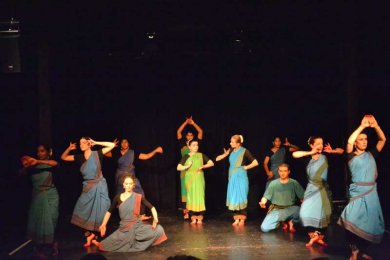 Students perform Kirtana Over the years, she has trained several dancers and had arangetrams of more than 33 dancers. Under the aegis of her school she also started arranging concerts of classical Carnatic music, lectures on Indian Art and workshops. Her training methodology was as per what she studied under Kamadeva and Adyar K Lakshman. She gave lessons in adavus, basic movements, followed by jathis, combination of adavus to dance sequences and at a higher level abhinaya. I saw her classes at the Vienna University and in her institution. The explanations she gave, correcting the dancers' postures and movements of arms for alignment and perfection was according to parampara and quite strict. Knowing Sanskrit, shlokas and Sanskrit terms she imparts training well. She knows that it is difficult to go beyond the glitz and glamour, and the training cannot be hurried up. Therefore she has devised special choreographic works for her students like T4 where they dance basic adavus and perform in five pointed star patterns. She knows that to learn varnam is tough, but till then to sustain their interest in dance she has devised few such choreographic works. In 1988-89 Radha Anjali received a grant from ICCR to study dance further. Later on in 1994 she studied Seraikella Chhau and in 2003 to 2004 she studied Kuchipudi under Raja and Radha Reddy. She has also obtained Ph.D from Vienna University, in dance for her thesis on classical Indian dance as a religious and philosophic phenomenon. 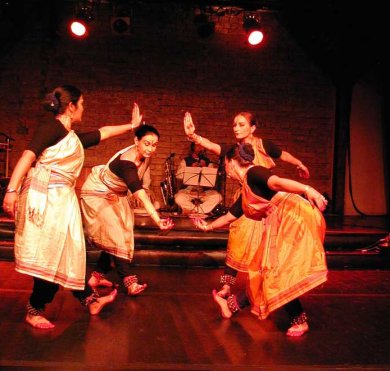 Furuikeya
Quite enterprising, she has choreographed few works which are quite interesting. Some I saw on DVDs. For her Natya Mandir Dance Company, a simple one was Sisya presenting her disciples who have mastered the basic training in various adavus in simple practice costumes. Sangama was an abstract piece of pure dance sequences. In Sari Dance, she used the Indian sari using Kathakali technique of using curtain to introduce the character with a group of Bharatanatyam dancers moving across the stage. In Furuikeya is sung the Japanese Haiku telling a story about a frog that jumped into an old pond and created ripples and patterns. Here Radha Anjali used 17 syllables of the Haiku transforming it into a tala five plus five plus 10. She toured India in 2007 presenting her group work with her Natya Mandir Dance Company and also gave solo performances. Some of her important works include Rasa (2009), Sisya (2011), Sikhandi (2011), Matru Chhaya (2012), Guru Pranam homage to Gurudev Rabindranath Tagore, (2012), Pranam in Memoriam of Kamadeva (2012), and Navagraha (2013). She has a busy career performing in Vienna and Europe. I saw her Sikhandi based on Mahabharata in Delhi in 2011 and found it a very strong work, using the original Sanskrit shlokas from Mahabharata. She presented it at Rukmini Arangam at Kalakshetra, Chennai. Under her Dance Project she had explained: "Otherness" is far from being accepted in our societies. The significance of gender and justification of same–sex associations, as well as transformation into the opposite sex represented in her production and choreography of Sikhandi. She had used the precise wordings in Sanskrit scriptures for this dance project receiving considerable acclaim. 
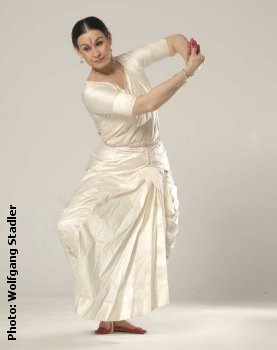
Mahabharata
Adyar K Lakshman had often visited Vienna for workshops as has Kalanidhi
Narayanan, staying with her family. Kalanidhi mami loved her kitchen
and would prepare food. She would go with Radha Anjali's mother to the
market and travel by tram and metro. Once both of them managed to go to
Salzburg and returned giggling like school girls from their adventure..
She fondly remembers Adyar K Lakshman sir and considers herself
fortunate to have performed along with 8 of her students from Vienna at
Kalakshetra's Rukmini Arangam for the Gurusamarpanam which Lakshman
Sir's daughter Induvadana Malli had organized in August 2015. She is actively involved with Austro-Indian Association and since 2008 she is the President of the Association, undertaking several cultural activities. She publishes Natya Mandir News which carries scholarly articles on dance and dance news of performances, lec-dems, workshops, activities of Natya Mandir, news about the disciples' performances, visiting artists and assists Austro-Indian Association in recording its activities as documentation, which amounts to history of the Association since its inception. I glanced through year wise the brief records and photos of musicians and dancers who have visited and performed in Vienna. I saw photograph of Rukmini Devi who visited Vienna in 1973 and gave lectures on Kalakshetra and Indian Art at Palais Palffy. Another important and historic photo I saw was of Dr. Rudolf van Leyden, who was a businessman and visited India and was also an art critic and helped several Indian painters in 1960s and 70s. He also assisted Kamadeva to stay in Vienna and run his dance company. Legendary musicians like Nikhil Banerjee (sitar), Ustad Asad Ali Khan, violinist T.N Krishnan, Bharatanatyam and Odissi dancer Kiran Segal, Shovana Narayan, Ronu Majumdar and several others have performed in Vienna and are featured in Austro–Indian Association of Vienna. As President, Radha Anjali caries on the all embracing work of her predecessors very competently. She informed me that she recently learnt how to make posters and mastered the technology. She showed me posters of Astad Deboo whose performance she had helped in organizing and had herself designed the posters. Similarly she designs Natya Mandir news bulletins recording major cultural events. 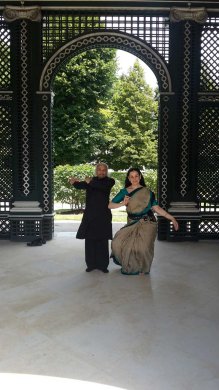
Sunil Kothari and Radha Anjali
at Schönbrunn palace One evening, Radha Anjali gave her disciples the day off and took me around for a stroll to nearby old and new town of Vienna. The churches nearby were absolutely the works of wonders and art. The market area, the bazaar, the shopping malls, the old university buildings would convince anyone why Vienna is such a beautiful city. We visited Shakespeare book shop. The amount of books and various sections were amazing. I was reminded of Shakespeare and Company in Paris which Sri Lankan poet Tambi Muttu ran. It was a meeting place of intellectuals, poets, authors, and an institution. I remembered visiting it with Dileep Padgaonkar. The visit would have been incomplete without going to Schönbrunn palace. Opposite the palace is the Emperor's coffee house, where he used to go and have coffee. It is a magnificent monument with fountains and terraces. The well manicured artistic landscape gardening, with pavilions, trees and fountains draw crowds and tourists. We visited the spot where we had taken photographs of Kama, Pradip Kar and musicians of Seraikella Chhau dances. I felt quite nostalgic.  Dr. Sunil Kothari is a dance historian, scholar, author and critic. He is honored with Padma Shri, Sangeet Natak Akademi award and Senior Critic Award from Dance Critics Association, NYC. Post your comments Please provide your name and email id when you use the Anonymous profile in the blog to post a comment. All appropriate comments posted with name & email id in the blog will also be featured in the site. |